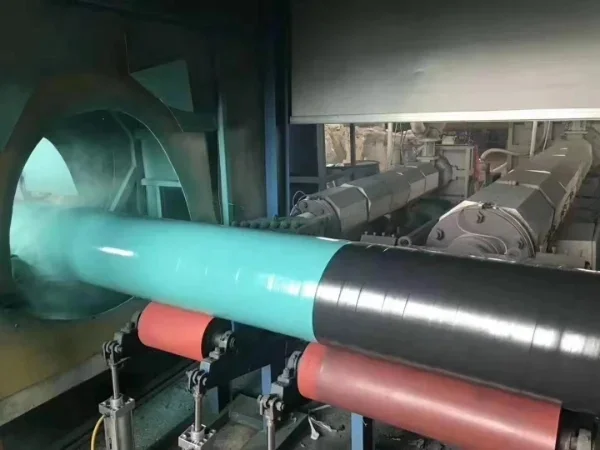How is 3PE coating produced?
3PE coating is a commonly used anti-corrosion coating, which is composed of three layers, namely the bottom adhesive layer, the middle anti-corrosion layer, and the outer protective layer. This coating has excellent anti-corrosion properties and can effectively protect pipelines from corrosion and damage, so it is widely used in oil, gas, chemical, and other industries. So, how is the 3PE coating produced? Let's take a closer look below.

First of all, the production of 3PE coating needs to go through the following steps:
1. Steel pipe surface treatment
Before 3PE coating, the surface of the steel pipe needs to be treated first to ensure that the coating can be firmly attached to the steel pipe. The surface of the steel pipe is usually cleaned and treated by sandblasting, shot peening, and other methods to remove impurities such as scale and rust on the surface so that the surface of the steel pipe becomes smooth and flat.
2. Primer adhesive coating
After the surface treatment of the steel pipe is completed, the underlying adhesive needs to be coated on the surface of the steel pipe. The primer adhesive is a special coating, which can tightly combine the middle anti-corrosion layer and the outer protective layer with the surface of the steel pipe to form a whole. The bottom adhesive is usually made of materials such as hot melt adhesive or epoxy resin, and the thickness and uniformity of the coating need to be well controlled during coating.
3. Intermediate anti-corrosion layer coating
After the primer coating is completed, the middle anti-corrosion layer needs to be coated on the primer. The middle anti-corrosion layer is the core part of the 3PE coating, which can effectively prevent the steel pipe from being corroded and damaged. The middle anti-corrosion layer is usually made of polyethylene, polyurethane and other materials. It is necessary to control the thickness and uniformity of the coating when coating.
4. Coating of the outer protective layer
After the intermediate anti-corrosion layer is coated, it is necessary to coat the outer protective layer on the intermediate anti-corrosion layer. The outer protective layer is the outermost layer of the 3PE coating, which can protect the middle anti-corrosion layer and prevent the steel pipe from being corroded by the external environment. The protective layer of the outer layer is usually made of polyethylene, polyurethane, and other materials, and the thickness and uniformity of the coating need to be well controlled during coating.
5. Curing and Detection
After the 3PE coating is applied, it needs to be cured and inspected. Curing refers to heating the coating at a certain temperature and time to cure it into a whole. Inspection refers to the quality inspection of the coating to ensure that the quality of the coating meets the requirements. Commonly used detection methods include thickness measurement, adhesion test, corrosion resistance test, etc.
The above is the production process of 3PE coating. Through these steps, 3PE coating with excellent anti-corrosion performance can be produced. It should be noted that the quality of each link needs to be strictly controlled in the production process to ensure that the quality of the coating meets the requirements. At the same time, it is also necessary to select the appropriate coating and coating thickness according to different use environments and requirements to achieve the best anti-corrosion effect.
The difference and advantage of 3PE coating and 3PP coating
Methods for connecting 3PE coated steel pipes
Characteristics and advantages of 3PE coating
Characteristics and process flow of 3PE coating






